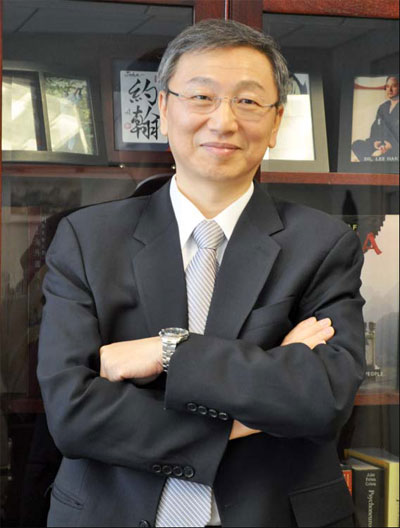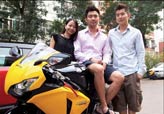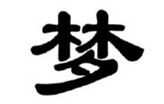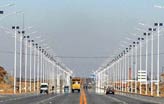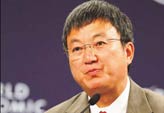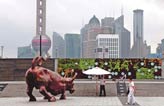Hot on the recruitment trail
Updated: 2011-09-16 08:53
By Ariel Tung (China Daily)
|
|||||||||
|
|
Pfizer scientist opening doors for Chinese talent in scientific research
In 2000, China accounted for only 7.1 percent of the world's total GDP. In 2005, it was the world's fifth-largest economy. But what Tan Lingshi saw at that time was an immense opportunity to invest in research and development of Western drugs in China.
As Pfizer's head of biometrics for Asia, Africa, the Middle East and Latin America, he made a compelling case for Pfizer to set up its first China R&D center in Shanghai. In 2006, Tan, who had lived in the United States since 1985, decided to go back to China to head Pfizer's R&D operation there.
Five years later, under Tan's leadership, the Shanghai R&D center has more than 400 local scientists and has become an integral part of Pfizer's global R&D network.
Tan, who was born and raised in Hubei province, left China when he was 25 years old to pursue his graduate studies in the US. He received his PhD in biostatistics and his master's in applied mathematics, both from the University of Pittsburgh.
The China that Tan sees today is not the same China he knew back then.
"China has 1.3 billion people and is a big part of the world. We really need to take China seriously. We want to go beyond providing products to China, to develop products there with local talents. This is our commitment to Chinese patients," Tan says.
The extremely rapid economic growth in China has given rise to a new level of prosperity which in turn leads to a demand for high quality drugs. At the same time, there is a "very strong unmet medical need in China" owing to an aging population, high rate of urbanization and an increase in cardiovascular diseases and strokes caused by "Western lifestyle and diet", Tan says.
He says he believes that cultivating scientific talent is critical in maintaining Pfizer's position as a leading R&D-based pharmaceutical company. China offers a great potential in that regard, he says.
"There are a lot of young, energetic people in China. Being a good scientist continues to be an honorable dream for them. For Pfizer to maintain its comparative advantage, we cannot afford to be behind in reaching out to this generation of scientists," Tan says.
In 2009, Tan was responsible for spearheading a graduate program at Shanghai's Fudan University, a joint graduate program between Pfizer and the university. This program, called Clinical Data Management and Statistical Programming, is tailored to cultivate local talent in meeting the needs of clinical research. Pfizer works closely with Fudan to design the curriculums and experienced Pfizer scientists teach most of the courses.
"There are a lot of trainable talents and workforce in R&D in China for pharmaceutical companies. We brought a global R&D platform to China so that local talents can be developed," Tan says.
Last year, as the Shanghai center celebrated its fifth-year anniversary, Tan and his team opened a second China R&D center in Wuhan.
Tan says setting up the Wuhan center is "an ideal way to engage the scientific community there", as the city boasts numerous scientific talent.
Moreover, the Wuhan investment is in line with the Chinese government's strategy to encourage investment in central China. Tan says the company received strong support from the local government to establish their center there.
China now presents numerous opportunities for Chinese scientists who are trained overseas, according to Tan. Since China opened its door for its first group of students to study abroad in 1978, almost 2 million students who studied in the West have returned to China as of last year. The rate of return for "sea turtles" (a term for Chinese returnees) is on the rise. Last year alone, about 135,000 Chinese returned to China, which represents an increase of 25 percent compared to 2009.
Unlike some of the wealthy students who are sent abroad to study by their parents, Tan had a tough life overseas. He remembers having less than $100 in his pocket when he arrived in the US more than 20 years ago. His family could not afford to send him money from China each month. He had to work in the university's cafeteria and a Chinese restaurant to make ends meet. He survived on the most inexpensive pieces of "meats" he could find - chicken feet - which is a popular side dish in China.
When the 25-year-old sent home his picture that Christmas, his parents got a shock. He had lost 45 pounds in just a few months.
Putting aside the initial hardship, Tan had the most wonderful eight years of his life in Pittsburgh. Two of his most significant life events took place during that period of time. He met his future wife, a fellow graduate student at Pittsburgh, and they got married in 1986. Their daughter was also born in Pittsburgh.
At a young age, Tan already had an entrepreneurial streak in him. While pursuing his PhD in biostatistics, Tan founded a performing arts company to promote Chinese kungfu together with a few friends. They hired eight marketing staff members and brought Chinese acrobats to the US to perform in major cities such as Chicago. Although the business was forced to close, Tan says he learned a lot of lessons from it. He says he also had the misfortune of losting all his money day-trading and the money he borrowed from friends on a 30 percent interest rate.
Luckily enough, when he received his doctorate, he was soon approached and recruited by Schering-Plough Research Institute in New Jersey. He worked there as a research statistician for three years, and then at Children's Hospital of Pittsburgh before joining Pfizer in 1996.
Tan says his early hardships prepared him for all the ventures later in his life. He was a first-grader at an elementary school when the "cultural revolution" (1966-1976) broke out. When it ended, he had just graduated from high school and was assigned to work in a tea farm by the government. The physical and mental toil was unbearable, but he quickly found a way out. When the government restarted the national college entrance examinations, he took part in it and was lucky enough to pass.
"Many others stayed in the tea farm for a long time and even had a family there. But I was there for a brief period of time. Looking back, the hardship was good. It made me strong and prepared me for life afterwards," Tan recalls.
After getting out of the tea farm, he went on to college and taught three years there before leaving for the US for his graduate studies. He has never looked back since.
Now, Tan is filled with optimism for China's future, especially in the field of medical science research and development.
"For China to be an R&D powerhouse, what you need is scientific talents. You need support and funding in R&D. It's probably helpful to have a strong demand for the products as well. All these put China in a promising situation," Tan explains.
"We talked about the growing number of homegrown scientists and top scientists who returned from world-class universities to China. The quality of scientists as measured by the number of scientific papers is also increasing."
A major new study by the Royal Society, the United Kingdom's national science academy, concludes that China is on track to overtake the US in scientific output possibly as soon as 2013. By 2008, the number of scientific papers published by China had surged more than seven-fold.
(China Daily 09/16/2011 page17)
